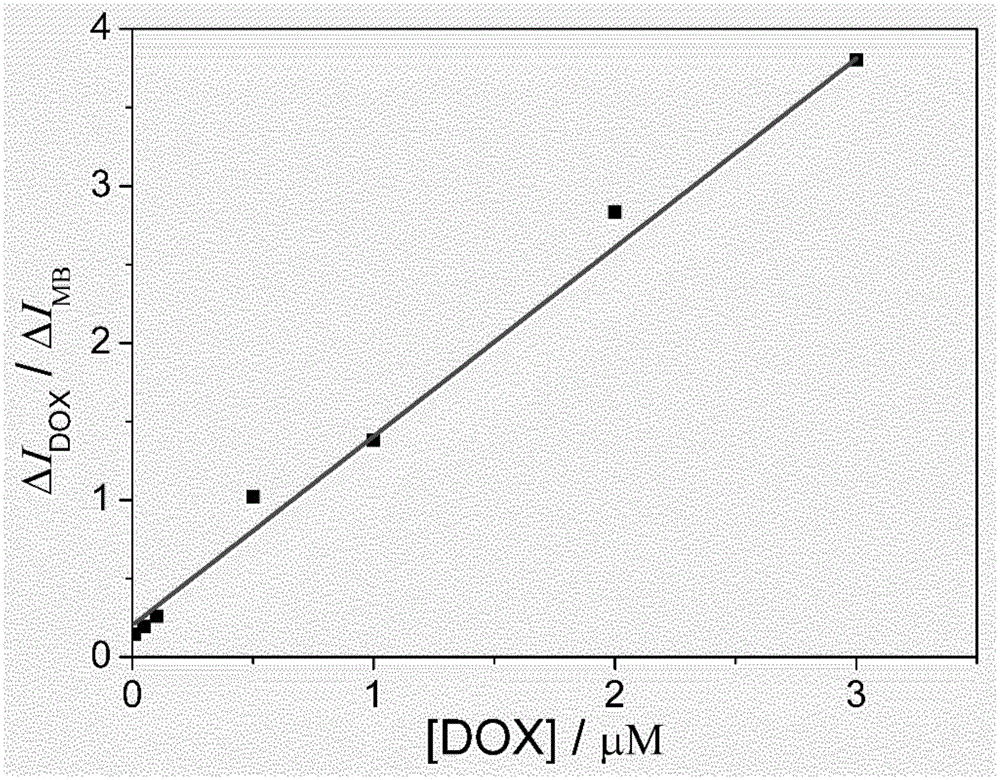Dual-signal electrochemical sensor for detecting doxorubicin hydrochloride rate based on bare glassy carbon electrode
A glassy carbon electrode, electrochemical technology, applied in the direction of material electrochemical variables, scientific instruments, instruments, etc., can solve the problems of high cost, complicated operation, etc., and achieve the effects of fast response, simple operation, and simple preparation method
- Summary
- Abstract
- Description
- Claims
- Application Information
AI Technical Summary
Problems solved by technology
Method used
Image
Examples
Embodiment 1
[0039](1) Prepare a PBS buffer solution with a concentration of 0.01M and a pH of 6.5. Take 50 μL of 1 mM MB solution dropwise into the PBS buffer solution under dark conditions. Under the same dark conditions, take different amounts of 200 μM DOX dropwise into the PBS solution of the above MB, and ultrasonically mix and disperse to prepare concentration gradients of 0.01 μM, 0.05 μM, 0.1 μM, 0.5 μM, 1 μM, 2 μM, and 3 μM. and 4 μM.
[0040] (2) The glassy carbon electrode is successively coated with 0.5 μm and 0.03 μm Al 2 o 3 The powder is ground into a mirror surface, then cleaned with deionized water, and then placed in deionized water and ethanol for 1 to 2 minutes of ultrasonication; the treated glassy carbon electrode is immersed in potassium ferricyanide solution for cyclic voltammetry scanning, so that the oxidation The reduction peak potential difference is less than 80mV; after the scanning is completed, perform the above-mentioned grinding and polishing steps aga...
Embodiment 2
[0041] Embodiment 2: the mensuration of actual sample
[0042] (1) Dilute human serum ten times with 0.01M PBS buffer solution, pH 6.5. Take 50μL, 1mMMB solution drop by drop into the human serum solution under dark conditions. Under the same dark condition, a certain amount of DOX was dropped into the above-mentioned MB human serum solution, and ultrasonically mixed.
[0043] (2) The steps of measuring the SWV signals of DOX and MB in the human serum solution with a glassy carbon electrode are the same as the step (2) of Example 1, and the content of DOX is determined according to the drawn standard curve.
[0044] The above-mentioned embodiment is a preferred embodiment of the present invention, but the embodiment of the present invention is not limited by the above-mentioned embodiment, and any other changes, modifications, substitutions, combinations, Simplifications should be equivalent replacement methods, and all are included in the protection scope of the present inv...
Embodiment 3
[0046] (1) Prepare a PBS buffer solution with a concentration of 0.03M and a pH of 7.0. Take 50 μL of 0.1 mM MB solution drop by drop into the PBS buffer solution under dark conditions. Under the same dark conditions, take different amounts of 100 μM DOX dropwise into the PBS solution of the above MB, and ultrasonically mix and disperse to prepare concentration gradients of 0.01 μM, 0.05 μM, 0.1 μM, 0.5 μM, 1 μM, 2 μM, and 3 μM. and 4 μM.
[0047] (2) The glassy carbon electrode is successively coated with 0.5 μm and 0.03 μm Al 2 o 3 The powder is ground into a mirror surface, then cleaned with deionized water, and then placed in deionized water and ethanol for 2 minutes for ultrasonication; the treated glassy carbon electrode is immersed in potassium ferricyanide solution for cyclic voltammetry scanning, so that the redox peak The potential difference is less than 80mV; after the scanning is completed, perform the above-mentioned grinding and polishing steps again, and blo...
PUM
 Login to View More
Login to View More Abstract
Description
Claims
Application Information
 Login to View More
Login to View More - R&D
- Intellectual Property
- Life Sciences
- Materials
- Tech Scout
- Unparalleled Data Quality
- Higher Quality Content
- 60% Fewer Hallucinations
Browse by: Latest US Patents, China's latest patents, Technical Efficacy Thesaurus, Application Domain, Technology Topic, Popular Technical Reports.
© 2025 PatSnap. All rights reserved.Legal|Privacy policy|Modern Slavery Act Transparency Statement|Sitemap|About US| Contact US: help@patsnap.com



